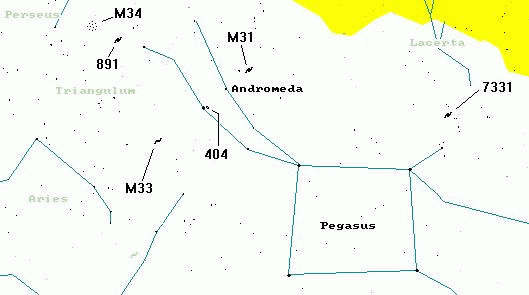Autumn: The Second Galaxy Season
Jack Kramer
We tend to regard spring as the "galaxy season" because the evening sky is oriented so that we can look out of the Milky Way, toward the area around the Virgo cluster. But in the fall, we can look out of the Milky Way in another direction and see many other galaxies in the neighborhood of Andromeda and Pegasus. As everyone knows, here we see M31 -- the largest, brightest galaxy visible from Earth (other than the Magellanic Clouds, which are only visible from the southern hemisphere). Right nearby is that other large, face-on galaxy, M33, which appears very faint due to its large angular size. However, there are many other interesting, but less renowned, galaxies in this area. We'll mention a few of them here, and there's a finder chart on the next page that will give you an idea where to look for them. But for most of the galaxies, you'll need a well-detailed star atlas.
In Andromeda is NGC 891, one of the more interesting objects. It's quite large and elongated, with dimensions of about 14.0' x 3.0'. (For those who might not be familiar with the way sizes are denoted, the single quote mark indicates the size in minutes of arc.) With an integrated magnitude 11.5, its light is spread out considerably, so it appears faint where the sky is light polluted. But in a dark sky, it's a gorgeous sight. What makes it special is the dark absorption line along its major axis. In the CCD image below, this feature is obvious, but it can also be seen visually in an 8" scope from a dark site. (All the images in this article were taken by Mike Purcell through his 10" Meade LX200 scope with an ST6 ot ST7 CCD camera.)
Another galaxy containing dark lanes is NGC 7331 in Pegasus. It's a little brighter at magnitude 10.4, but it, too, is quite large (11.4' x 4.0'), so its overall appearance is not quite as bright as you might expect. Nevertheless, I've even seen it with a 70mm copyscope from my backyard in Libertyville; it appeared as a faint, elongated hazy patch. My notes indicate that in the 10" scope there appears to be an absorption feature along the west margin of the galactic disk. This is seen as a more sharply defined right margin in another of Mike Purcell's CCD images. Another interesting aspect of NGC 7331 is that it's generally believed to be of the same size and configuration as the Milky Way, so as we observe it, we are probably seeing how our own galaxy would look were it possible to see it from about 50 million light years away.
Note also that another small, faint galaxy appears in the lower left edge of the CCD image. This is NGC 7335, which is the brightest of several galaxies surrounding NGC 7331. However, at magnitude 14.7, it's a challenge even at a very dark site. I just glimpsed it in the 10" at 177x from Groezinger's farm near the Mississippi River in far western Illinois.
In the same area is Stephan's Quintet -- five very faint galaxies in a tight group. The galaxies and their magnitudes are NGC 7317 ( 15.3), 7318A ( 14.9), 7318B (14.4), 7319 (14.8), and 7320 (13.8). I've seen other estimates that place them each at about a magnitude brighter. Nonetheless, this is for those observers who enjoy a challenge! You won't find these faint galaxies shown in anything other than the Uranometria or other specialized atlases; however, check the finder chart on the following page. The following CCD image should also be a help once you're in the field; unfortunately, the images lose a lot of detail here in the printing process.
I've seen Stephan's Quintet with some difficulty in the 10" scope; this was from a very dark site. When it comes to sorting out which galaxy is which in your scope, you pretty much have to judge this based on their brightnesses relative to each other.
Let's end up with something easier. Though there's nothing particularly interesting about the galaxy NGC 404, it's unique because of its close proximity to the star ( Andromedae. Of course, the star is in our own Milky Way galaxy and NGC 404 just happens to lie along the same line of sight millions of light years beyond. First get the star in your field of view, then move it just barely out of the field and the galaxy will pop into view to the north and slightly west. The finder chart here is somewhat misleading, because the star is virtually superimposed on the galaxy.
We've hit just a few denizens in this area of the sky, but don't stop here. Get out your charts and search out the many other objects. In particular, check out the large, nearly edge-on spiral galaxy NGC 7640, which has many features visible in our telescopes, including dark lanes. The "Second Galaxy Season" has a lot to offer.
Using the finder chart below NGC 891 can be found by starting at the last star in the "flattened V" of Andromeda, then moving about a third of a degree to the left. It lies roughly halfway between this star and the bright open cluster M34 in Perseus. To find NGC 7331, start at the star ( Pegasi (the "top right" star in the square of Pegasus) and follow the chain of stars that leads just about right to it. Once you're on NGC 7331, you can launch your quest of Stephan's Quintet (see map). Head south and slightly to the west until you find the pair of relatively faint stars that lies just to the north of the Quintet.
 Published in the October 1995 issue of the NightTimes
Published in the October 1995 issue of the NightTimes





